Magickal materials: Beeswax
Posted by Michelle Gruben on
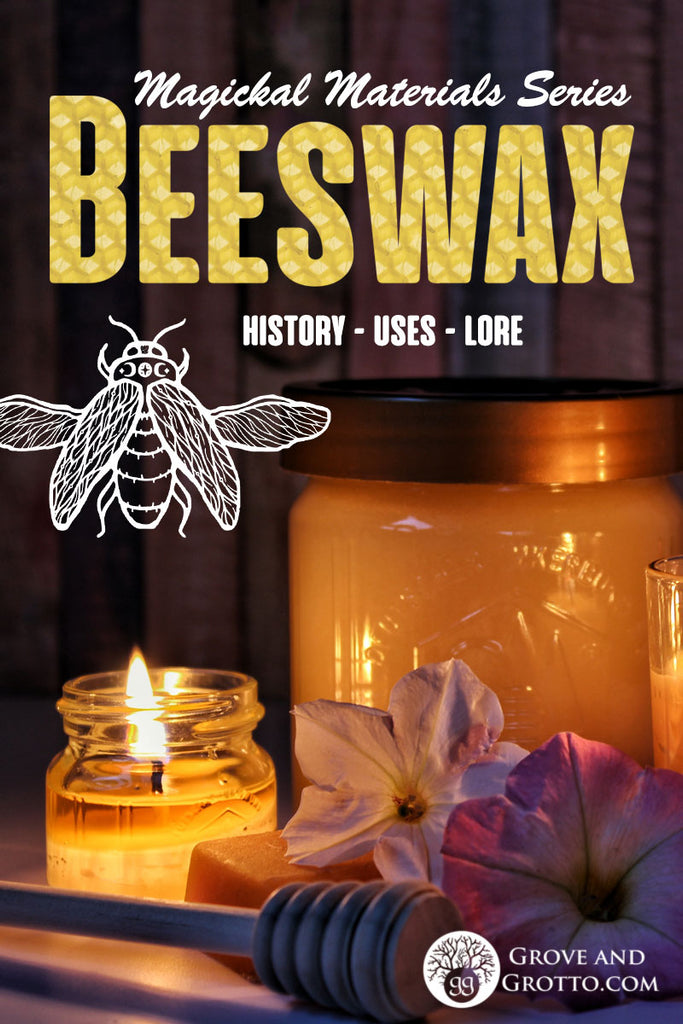
What’s sweet and golden and comes from bees? Nope, not honey! Today, we’re taking a closer look at a versatile magickal ingredient: Beeswax.
Beeswax may serve the Witch in a number of ways. Beeswax is crafted into candles, poppets, talismans and seals. It is an ingredient in ointments and natural body products. It has the marvelous property of anchoring and blending other spell ingredients together into a harmonious whole.
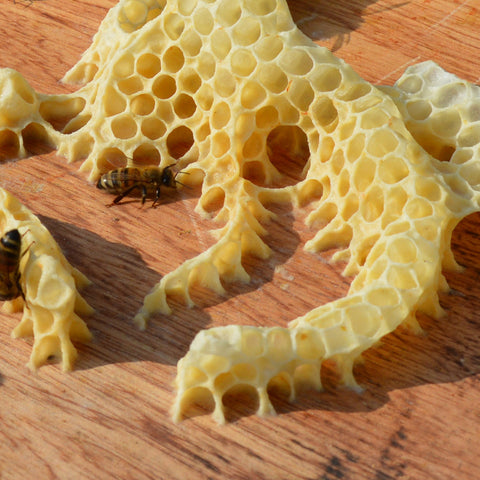
When ancient tablets and medieval grimoires speak of “wax,” they are almost always referring to beeswax. Petroleum-based wax hadn’t been manufactured yet, and vegetable waxes were inferior to work with. Beeswax was once prized for being rare and hard to obtain. Though apiary technology has improved in the last two centuries, beeswax is still a comparatively precious ingredient for ritual items.
Beeswax has an unmistakable allure to witchy folks. Perhaps something about it stirs our ancient souls. I first encountered beeswax as a child, nibbled from jars of honey in a downtown farmers market. I feel the same way about it now as I did then: Equal parts mysterious, delicious, and totally gross. Read on to find how to incorporate this ancient material into your magick.
Beeswax candles

Most ritual candles today are made from paraffin, a petroleum byproduct. Paraffin is inexpensive and has a high melting temperature—two strong advantages over beeswax. Despite what many people believe (or have been told at pioneer parks), beeswax was probably not often used for candle-making in centuries past. It’s far too expensive—animal tallow was the usual ingredient for household candles.
Even so, many Witches prefer natural materials for magickal workings, and beeswax fits the bill. Pure beeswax candles can be purchased as specialty stores or made at home. Some Pagans like to incorporate dried herbs or essential oils into their purpose-made beeswax candles
There are three basic types of beeswax candles: Poured, dipped, and rolled:
With poured candles, wax is dispensed into a mold or container and allowed to cool. It takes a lot of skill and materials to make poured beeswax candles that burn properly. Beehives and flowers are popular motifs for commercial candles, but the resourceful Witch could make a beeswax figure candle.
Dipped candles are made by repeatedly dipping the wicking string into a pool of molten wax. Dipping candles is time-consuming, but yields appealing rustic-looking candles. You can speed up the process by dipping more than one at a time. Hand-dipped candles have a bumpy surface that looks good and creepy—perfect for a Witch’s altar!
Rolled candles use sheets of beeswax rolled around a wick. Beeswax sheets are usually stamped with a beeswax pattern and come in all sorts of colors. Beeswax is brittle at cold temperatures—the tricky part is getting them at the right temperature so that they roll without squishing or splitting. (Not having the skill or patience to make them myself, I stock some wonderful rolled candles by Lailokens Awen.)
People who use beeswax candles may notice a frosty-looking coating on the outside of candles after shipping or storage. Beeswax’s sensitivity to changing temperatures is responsible for beeswax “bloom." The whitish cast is nothing to worry about—rather, it is a sure sign that the candle is made from pure beeswax. To remove beeswax bloom, warm the candle between your hands for a few moments, then buff with a soft cloth. Textured candles can be restored with a quick blast of warm (not hot) air from a hairdryer.
Beeswax candle have a light, pleasant scent of honey when burned. When properly wicked, they burn with a bright and smokeless flame. Many makers prefer to leave beeswax candles unscented, so as to not overpower their natural fragrance.
Beeswax poppets
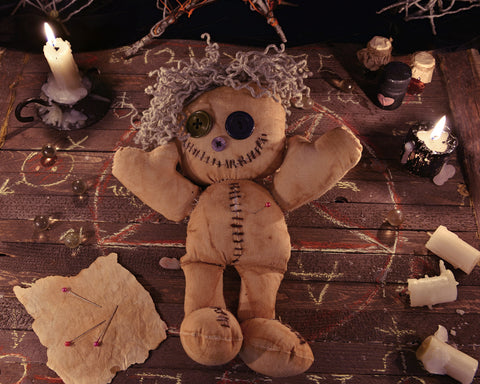
A poppet is a (usually) human figure, made to stand in for an individual in a magickal spell. A Voodoo doll stuck with pins is the image that first comes to mind, but poppets are also used for healing and benevolent magick.
Poppets are often fashioned from cloth or sticks. However, some practitioners prefer a poppet of beeswax (“wax baby” or “wax dolly”). Beeswax begins to soften at body temperature and has a flesh-like, organic feel. The malleable quality of wax allows for a more detailed and realistic figure.
To make a wax poppet, melt a small amount of beeswax in a double boiler, or a metal bowl sitting over a container of hot water. (Don’t allow the water to come to a boil. Beeswax melts around 145 degrees Fahrenheit and is pliable at around 100 degrees. Higher temperatures can cause dangerous spattering or even combustion.) Remove from heat and allow to partially cool. When the wax is cool enough to handle, scoop it up and begin to shape your poppet. The heat from your hands will keep the wax soft while you work it.
Talismans and seals
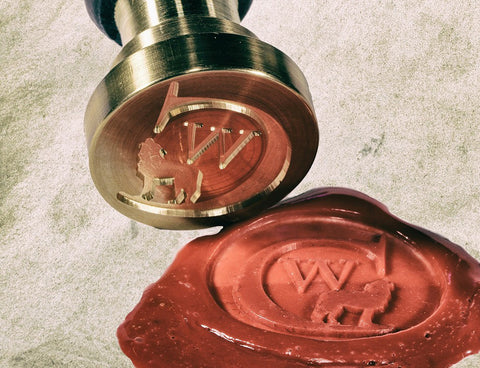
Beeswax is an age-old ingredient for making seals. The melted wax is combined with powdered tree resin to make a glossy, fragrant, and magickally potent seal. Gold Damar is the most traditional choice, but practically any resin will work. Some people add natural or artificial colorants to tint the wax.
Use beeswax seals on magickal bottles and documents. While the seal is still soft, symbols may be carved or stamped into the wax.
In the Western occult tradition, beeswax is often used as a base for magickal seals. The famous Sigillum Dei Aemeth of John Dee was made of wax. Wicca founder Gerald Gardner suggested that the Wiccan altar pentacle be cast or carved in wax. That way, it could be quickly melted down and disposed of if the Witch was under investigation by authorities.
One of the main magickal advantages of beeswax is its suggestibility. In other words, it can take on whatever meaning the magician impresses into it. It will also absorb the influences of anointing oils, herbs, and other materials used in conjunction with the wax. Beeswax, properly prepared, may be used as a substitute for other materials that are impractical to obtain or work with. Ceremonial magicians use beeswax to create planetary talismans in the absence of certain alchemical metals—namely, Gold, Lead, and Mercury.
Perfumes, salves and ointments

Beeswax is an important ingredient in natural cosmetics and perfumes. Beeswax binds together scented ingredients, helping to lock in their fragrances. Heat from fire (or from the skin) softens the wax, releasing the aroma into the air. Amber and Kyphi—the famous blended incenses of the ancient world—were prepared using a beeswax base.
Witches often include beeswax in recipes for sacred perfumes and ointments. They believe that it is more magickal to use ingredients from the plant and animal world than modern, lab-created chemicals. Solid perfumes made with beeswax yield a subtle, slow-releasing fragrance that’s ideal for ritual use.
Typically, a certain percentage of melted beeswax is added to a base of fat or oil. The ratio depends on the desired consistency. More beeswax will make the mixture stiffer, less will make it creamier.
Beeswax makes an excellent natural polish for magickal items made of wood. You can make your own with a mix of carrier oil, melted beeswax, and essential oils. Rub onto wands and other wood items, and buff with a soft cloth.
Obtaining beeswax

Beeswax is commercially available from soap- and candle-making suppliers. It is sold in blocks, textured sheets for rolled candles, or pastilles (small pellets). The processor melts and filters the raw wax to remove pollen, bug parts, and other impurities. Filtered beeswax is available in yellow (natural color) and white (color removed). Unfiltered beeswax is dark yellow to brown and used for industrial purposes.
Beeswax is quite expensive compared to other candle waxes—around $8-10 per pound. Bees make around 10 pounds of honey for every pound of beeswax. If the price is too low, it is possible that the beeswax has been stretched with soy wax or other additives.
While beeswax is readily available online, it can also be purchased directly from beekeeper. Buying close to home supports local bee populations and adds a little bit of local Earth energy to your magick. If you enjoy working with beeswax, you may wish to “give back” to the bees in some way. Consider growing plants that bees enjoy (such as Lemon Balm or Lavender), or contributing to conservation efforts.
Magickal properties of beeswax
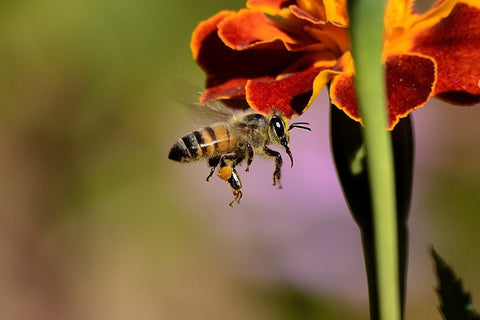
Magickally speaking, bees are funny little buggers. All stinging insects are considered creatures of Mars. They are warrior spirits. They travel in armies, and are willing to die to protect the nest.
Yet bees have a sacred association with the Mother Goddess. Bees are matriarchal, and the products they make are sweet and nourishing. It is not for nothing that honey has been called the “food of the gods.”
Images of a bee goddess have been found in ancient art in the Near East and Aegean regions. The title “Melissa” means Queen Bee, and was at various times applied to Cybele, Aphrodite, Demeter, and Artemis. Her priestesses were known as “melissae” or “meliae” (honey-nymphs).
Bees and bee products carry the symbolic virtue of industry and cooperation. Each bee is tiny, its contribution minuscule. But as a group, they create enormous benefits, building enormous colonies and pollinating the world’s plants.
Bees build their colony from beeswax in six-sided cells. The honeycomb shape mirrors the Seed of Life and the hexagram of sacred geometry.
Beeswax is a pleasant and adaptable ingredient with many magickal applications. Hopefully this article has given you some new ideas about how to use it in your spells and recipes!
Read more in the magickal materials series, or check out the archive.
